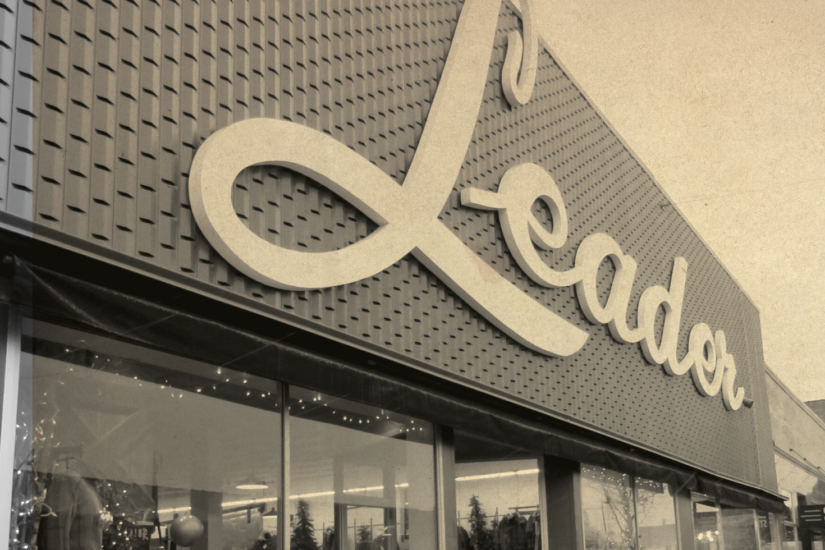
Succession Success
How a new generation of owners is reinventing a 100-year-old department store in Cambridge.
By Lisa Meyers McClintick | Photography by Lisa Meyers McClintick
The ceilings have been returned to tin tiles that add old-time elegance. Re-exposed red brick looks both vintage and modern. And the original wood floors shine again, creaking as longtime customers walk into Leader, the department store that has anchored Cambridge’s Main Street for a century.
Gail Mattson greets a customer by name as soon as he’s through the door. As the men’s clothing and tuxedo buyer at Leader, Mattson carefully curates racks of fleecy, winter-friendly outerwear and clothing, shelves of sturdy boots, gloves and hats. She is one of two employees who have walked these floors for 20 to 30 years. “I think people are beginning to appreciate service again,” she said. “We try and hang our hat on taking care of people.”
While customers check out Leader’s refreshed and condensed retail space, much of the buzz comes from the warm glow through a brick archway. That’s because last December, two of the Twin Cities’ top chefs—both with Cambridge roots—opened Willards, a restaurant that elevates regional dining, with offerings that include chicken liver toast and grilled cabbage salad. Wide open and welcoming, the restaurant draws loyal customers from as far away as the Twin Cities. It has also boosted earnings at the retail store, a welcome development as Leader passes into the fourth generation of its founding family.
It’s a major coup for Cambridge to keep a downtown retail anchor and help it flourish, especially as it bucks the trend of businesses closing when their Baby Boomer owners retire. According to University of Minnesota research, about 67 percent of small business owners were born before 1967, and they provide approximately 64 percent of new, private-sector jobs.
Neil Johnson was the third generation in his family to own Leader. As the store celebrated its 100th anniversary last year, sales were flat and no one in the family was interested in taking over the business. Then luck and serendipitous timing intervened.
“Leader has put Cambridge back on the map in a good way,” said Grant Johnson, Neil’s nephew, who can remember sitting on his Grandpa’s lap in the store. While he didn’t grow up in Cambridge, both his parents were raised within two blocks of the store. He now co-owns Leader with Erick Harcey, a James Beard-nominated chef who drew acclaim with his former Minneapolis restaurants, Upton 43 and Victory 44.
With a six-month renovation plan and close to $2 million in financing, including an Initiative Foundation lending package, Johnson and Harcey emphasized their desire to build a legacy for the community and re-energize downtown. On a personal level, they yearned for a better work-life balance.
“We know the grind of the industry,” Harcey said. “How do we do what we love, but be home? We’re dads and husbands first and foremost.”
Paths Converge
It was a delicious bite of walleye on a flax crisp that brought Johnson and Harcey together.
Johnson had moved back to Minnesota after years as a chef in California and was working at Tullibee, the restaurant in the Hewing Hotel in Minneapolis. During spring 2017, Johnson was attending a charity event where that walleye was served; he loved it so much that he sought out its creator—Harcey—and the men discovered their Cambridge connection; not only was Harcey from Cambridge, he had worked in the Leader men’s department.
At the time they met, Harcey had achieved success with his much-loved Twin Cities’ restaurants. But he was also exhausted from a grueling two-hour back-and-forth commute to his hometown of Cambridge, where he spent his scant free time hunting and fishing with his four sons, ages 8 to 13. Johnson, who has two daughters and a son ages 6 to 13, was also reevaluating his professional options.
By December 2017, Johnson had left Tullibee and Harcey had shuttered his restaurants to search for a new location, which eventually led him to reach out to Neil Johnson about opening a restaurant in Leader. When word of this reached Grant Johnson, who owned a third of the building with each of his siblings, his jaw dropped. It was, he felt, a perfect opportunity.
Within two weeks, Johnson and Harcey were sitting down with their wives, swapping life stories and feeling an instant connection and a pull toward partnership. Their merging of talents and ideas also fueled a fresh chapter for a downtown flagship that—until then—had no succession plan.
“This is more than a next job for us,” Harcey said, “but also ‘What’s good for Cambridge?’”
A Store for a New Century
Historic photos on the walls show Leader’s evolution, from early 1900s dry goods and necessities, to dime-store bins, fabrics, notions and groceries, to its mid-century heyday, when newspaper ads tempted holiday shoppers with dolls, skis, snowmobiles and Schwinn Sting-Ray bicycles.
Leader’s status as a retail force in Cambridge started to change in the late 1980s, when Highway 65 traffic was rerouted from Main Street to the east side of town. It was a trend seen throughout the country as big-box retail chains popped up. The advent of online shopping in the 2000s compounded the trend and further chipped away at the foundation of brick-and-mortar mom-and-pop stores. Even downtown Minneapolis’s venerable Macy’s, known for most of its 115 years as Dayton’s, closed its doors at 7th Street and Hennepin Avenue in 2017. St. Cloud lost its anchor downtown department store, Herberger’s, in 2018.
Adding a restaurant to the struggling Cambridge retail space was, the partners decided, a creative way to bring in more foot traffic.
To revive Leader, Johnson and Harcey needed an ambitious budget to add the kitchen and follow modern fire and safety codes. They filled dumpsters with decades of clutter, carpet and ceiling tiles. They returned the building to its original look, peeling back the layers, which delighted Johnson’s 92-year-old great aunt, who could remember the pendant lights hanging above women’s clothing. Windows that bring in the golden glow at sunset were rediscovered.
Financing for the project came from a number of sources, including Cambridge State Bank, Minnesota Business Finance Corporation, the city of Cambridge, and family members. The Initiative Foundation originated a $100,000 loan for the project and sold one-third of it to the Cambridge Business Development Corporation (a private local development group) and one-third to the East Central Regional Development Commission. The move helped to balance the risks and rewards and invited more players to share in the pride of a noteworthy downtown redevelopment project. Another anticipated benefit of the project is that employment is expected to increase from a half dozen to more than 30.
Part of the rationale for expansion: While Cambridge may have a population of just 10,000 people, an estimated 150,000 residents live within a 20-minute drive—a do-able distance for a memorable dinner.
“This was a great opportunity, not only for Leader and Willards, but for downtown Cambridge and the community as a whole,” said Dan Bullert, Initiative Foundation business finance manager.
New Spaces
Under the new business plan, retail floor space shrank from 9,000 to 6,000 square feet to make room for Willards, which takes up 3,000-square-feet. The restaurant holds about 70 people and includes counter seating, where diners can watch chefs at work crafting what’s been dubbed the Twin Cities’ best burger (topped with tangy pickles using Harcey’s grandma’s recipe), Swedish meatballs, wild rice ice cream and a hot beef sandwich that was perfected by Harcey’s late grandfather, Willard, who in the 1950s owned and operated The Lighthouse restaurant in downtown Cambridge.
Harcey’s grandmother came in to try the hot beef recipe, which has long been a family comfort food. The new store honors family ties in other ways, too. Johnson’s great aunt Doris, who is 96, can be seen at age 13 in the back of a black-and-white photo in the retail area.
There is an upstairs for offices, a basement for storage and an event space that can seat another 70 people or be used for pop-up retail events. Like the upstairs, the basement walls tell stories with old photos and behind-the-scenes treasures, including an ingeniously engineered and rare hand-crank Lagerquist elevator that still works but had to be decommissioned due to modern codes.
Outside the store, crews have repainted the rusty green-and-ivory facade to a new dark gray and white, keeping the familiar Leader lettering. Other downtown businesses have also tidied their appearances and may be able to benefit from more people coming into Cambridge for the restaurant and shopping.
“When we all grow, we grow together,” Johnson said. “There’s a lot of pride in this community.”
Succession Planning 101
Keeping Central Minnesota’s Businesses
Rural towns across Minnesota are going through a “silver tsunami” as small business owners face retirement without anyone to continue the businesses they’ve built. According to University of Minnesota research, about 67 percent of small business owners were born before 1967, and they provide approximately 64 percent of new private-sector jobs. Without the financial (and philanthropic) benefits of these businesses, local communities can lose goods, services and overall stability.
To support these businesses and to help with possible succession plans, the U of M suggests:
- Form a local committee, which can create a database of businesses and keep track of the owners who are nearing retirement.
- Create a network of local resources, such as attorneys, real estate agents, bankers and city officials, to support both families selling their business and prospective buyers.
- Look for programs that can help hone solid business plans, such as the Small Business Development Centers, Senior Corps of Retired Executives (SCORE), or Exit Planning Institute’s Minnesota Chapter, which includes professional advisers for business succession.
Learn more information on succession planning from the University of Minnesota Extension Service.
